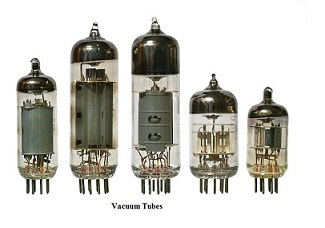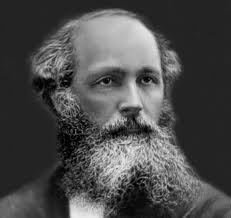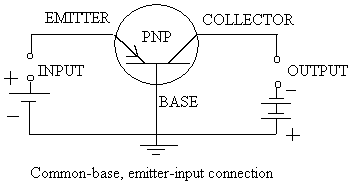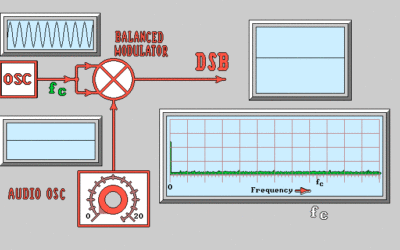Basic Understanding of Valves:
 The vacuum tube, in its very primitive form, evolved from the light bulb. Invented by Thomas A Edison in 1883, the incandescent lamp, had 3 basic necessities to operate:
The vacuum tube, in its very primitive form, evolved from the light bulb. Invented by Thomas A Edison in 1883, the incandescent lamp, had 3 basic necessities to operate:
The Envelope, The Filament, The Vacuum
The envelope is basically a sealed container, a box or jar so to say, which completely surrounds (envelopes) whatever is inside.
The first envelopes were made of glass, however, there was no written law that they must be made of glass. In fact, many modern tubes have metal and/or ceramic envelopes. The filament, otherwise known as the heater, was the basis of the light bulb.
The idea was that if a high enough electrical current flows through a coil of wire, it generates light (and heat). Edison’s object, was to create a thin enough piece of wire, that even a very low current could generate a great amount of light. The problem was that he kept burning up the filaments. They would work for a matter of seconds, then die out. He experimented with many different filament materials. Finally he found a metal material that would last – tungsten. Most modern filaments are made up of a thoriated tungsten material.
The vacuum was added along the way, as an attempt to keep the filament from burning out. It was logical, that in order for fire to exist, you must have oxygen. So Edison assumed that if all the oxygen were removed, by creating a vacuum, the filaments would stop burning up. It helped, but was not the solution to the problem.
He did find, however, that if a filament were energised within a vacuum, that after time, a “shadow” would be left on the inside of the glass, which resembled the shape of the filament. He surmised from this, that within a vacuum, particles (we now call them electrons) were emitted around the wire, forming a cloud, or SPACE CHARGE. (refer to fig. below ).
This effect became known as the EDISON EFFECT, which is the basic operating theory behind all vacuum tubes.
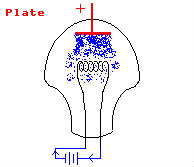 During his experimentation on the electric light bulb, Edison found that many metallic substances will emit electrons when heated to incandescence. In a light bulb, these emitted electrons become waste, as they serve no useful purpose. The vacuum tube is, however designed to make use of these emitted electrons. Edison experimented by placing a second ELEMENT, or ELECTRODE within the vacuum along with the filament, but not touching it. He then connected an ammeter to the second element, and attached the other lead of the ammeter to the positive terminal of the battery. He found that when doing this, current would flow through the ammeter. The second element is called the PLATE (ref at right)
During his experimentation on the electric light bulb, Edison found that many metallic substances will emit electrons when heated to incandescence. In a light bulb, these emitted electrons become waste, as they serve no useful purpose. The vacuum tube is, however designed to make use of these emitted electrons. Edison experimented by placing a second ELEMENT, or ELECTRODE within the vacuum along with the filament, but not touching it. He then connected an ammeter to the second element, and attached the other lead of the ammeter to the positive terminal of the battery. He found that when doing this, current would flow through the ammeter. The second element is called the PLATE (ref at right)
The emitted cloud of electrons, bearing a negative charge, is attracted to the positively charged plate. It flows through the vacuum toward the plate and is collected upon its surface. This action was monitored and proven by use of the ammeter. But what happens if the plate is connected to the negative side of the battery? Edison discovered that when this is done, NO current flows through the ammeter. So electricity flows, within the vacuum, in one direction only – from Negative to Positive. This was in direct contradiction to Benjamin Franklin’s conventional theory, that electricity, being a fluid (much like water), flowed from positive (a full glass) to negative (an empty glass).
Edison further reasoned that since, with the polarity reversed, the negative particles of electricity didn’t flow from the plate to the filament, that there must be some outside force causing the electrons to leave the filament. He discovered that while he was working with a heated filament, the plate was not heated. The heat of the filament caused the electrons to be “boiled” off, and freed from the solid matter of the filament into the surrounding vacuum. Once the electrons were freed from the confines of the solid matter, they could be attracted to any positively charged source within the vacuum. This is known as THERMONIC EMISSION, which is the process of the electrons being forced out of the solid metal via thermal agitation.
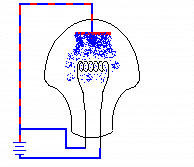 This is the basic concept of the FLEMING VALVE invented by J. Ambrose Fleming in 1904. It was noted that since electricity flowed within a vacuum tube in one direction only – from the filament to the positively charged plate, it was as if there was a “one way valve” placed in the circuit. By this method, a direct current (DC) charge, formerly only available by chemical production through a battery, could now be converted from an alternating current (AC) source. This outstanding development was called RECTIFICATION and the Fleming Valve was known as a DIODE (two element) RECTIFIER. It wouldn’t be until 44 years later that the crew at Bell Labs would recreate this effect using semiconductor materials.
This is the basic concept of the FLEMING VALVE invented by J. Ambrose Fleming in 1904. It was noted that since electricity flowed within a vacuum tube in one direction only – from the filament to the positively charged plate, it was as if there was a “one way valve” placed in the circuit. By this method, a direct current (DC) charge, formerly only available by chemical production through a battery, could now be converted from an alternating current (AC) source. This outstanding development was called RECTIFICATION and the Fleming Valve was known as a DIODE (two element) RECTIFIER. It wouldn’t be until 44 years later that the crew at Bell Labs would recreate this effect using semiconductor materials.
 The AUDION came about when Lee DeForest, In 1906, added a 3rd element between the two. This third element, a control grid, allowed one to electronically control the output of the tube based directly upon the input. This was the birth of Amplification. The term AUDION was later replaced by the term TRIODE, as the tube has 3 elements within the vacuum. Later improvements included the adding of 2 more elements, the suppressor and accelerator grid, which allowed higher frequency operation, increased stability, and eliminated unwanted oscillation. The 4 element tube was called a TETRODE and the 5 element tube was called a PENTODE.
The AUDION came about when Lee DeForest, In 1906, added a 3rd element between the two. This third element, a control grid, allowed one to electronically control the output of the tube based directly upon the input. This was the birth of Amplification. The term AUDION was later replaced by the term TRIODE, as the tube has 3 elements within the vacuum. Later improvements included the adding of 2 more elements, the suppressor and accelerator grid, which allowed higher frequency operation, increased stability, and eliminated unwanted oscillation. The 4 element tube was called a TETRODE and the 5 element tube was called a PENTODE.
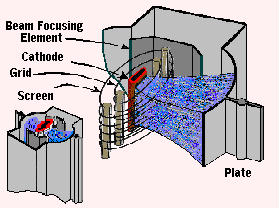 The biggest problem in tube design came when trying to reach higher power levels, at higher frequencies. The higher the frequency, the tighter the tolerances became. In an effort to overcome this problem, the BEAM POWER TUBE was developed. This tube was special, in that it FOCUSED a BEAM of electrons, rather than simply creating a cloud of electrons boiled off the cathode. The beam is focused by applying a sufficiently high negative potential to repel the electrons being boiled off the cathode. At the same time the highly positive plate is attracting the negatively charged electrons. This focused beam of electrons places more energy directly on the plate, eliminating losses, and allowing distribution.
The biggest problem in tube design came when trying to reach higher power levels, at higher frequencies. The higher the frequency, the tighter the tolerances became. In an effort to overcome this problem, the BEAM POWER TUBE was developed. This tube was special, in that it FOCUSED a BEAM of electrons, rather than simply creating a cloud of electrons boiled off the cathode. The beam is focused by applying a sufficiently high negative potential to repel the electrons being boiled off the cathode. At the same time the highly positive plate is attracting the negatively charged electrons. This focused beam of electrons places more energy directly on the plate, eliminating losses, and allowing distribution.
Even today, in the age of the semiconductor, we can not do without tubes. This is why I insist that we still study them. They are still (as of the year 2000) used in Televisions, Computer Monitors, Microwave Ovens, Medical Equipment, Radar, Transmitters, and many other phases of high tech electronics.
We use some tubes, such as the big red ones d above, that are as large as a man. There is also a new wave of “nanotube” technology which might be worth riding. The point is, that tubes are not dead, nor will they be for quite some time, and should be taught as a viable technology.
